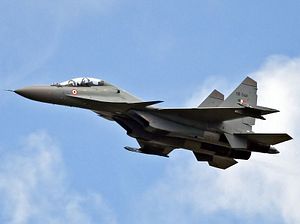The Indian Air Force (IAF) will test fire a nuclear-capable BrahMos-A supersonic cruise missile from a Sukhoi Su-30 MKI multirole air superiority fighter jet in November or early December of this year, The New Indian Express reports. The test firing will be preceded by a drop test in August to validate the aircraft’s release mechanism, according to the missile’s manufacturer.
“We hope to conduct the drop test by [the] 24th of this month (August),” the head of BrahMos Aerospace, Sudhir Mishra, said. “After the drop test, we will see if some refinement in the software and other systems is needed,” he added. The test will be conducted in Rajashtan’s Pokharan firing range.
The BrahMos-A is an air launched variant of the BrahMos cruise missile, has lesser weight (2.55 tons) than other models and features additional rear fins for aerodynamic stability. The missile’s range is estimated at around 290 kilometers (180 miles). The BrahMos-A can alternatively be fitted with a 200-kilogram conventional or 300-kilogram nuclear warhead. While originally developed as an anti-ship missile, it can also engage land targets.
It operates on a so-called fire and forget principle and can be dropped from 500 to 14,000 meters (1,640 to 46,000 feet). The missile’s terminal altitude is as low as ten meters. (The ship-launched anti-ship version of the BrahMos can fly 3-4 meters above the sea to avoid detection.) The BrahMos is capable of traveling at speeds of up to Mach 3.0, making it one of the world’s fastest cruise missiles.
A first flight test of a Sukhoi Su-30 MKI with a BrahMos-A took place this June. Despite its titanium airframe and high-strength aluminum alloys, the undercarriage of the Sukhoi Su-30 had to be strengthened prior to the flight in addition to a number other modifications. Next to new hard points, the aircraft was fitted with hardened electronic circuitry to withstand the electromagnetic pulses of a nuclear blast.
For the IAF this is the first time that a heavyweight supersonic cruise missile will be integrated with a long-range multi-role air superiority fighter jet. Given the size and weight of the BrahMos, the Su-30 MKI is only capable of carrying one missile in a transport launch canister. The Su-30 MKI has a flight range of approximately 5,200 kilometers (3,230 miles) and can carry a payload of up to 8,000 kilograms (17,600 pounds).
While two Su-30MKI have been modified for the launch trials, the IAF plans to induct around 40 Su-30MKI aircraft integrated with the BrahMos missile. Overall, the IAF will receive 200 air-launched BrahMos-A missiles in the years ahead. India is also slated to upgrade its future fleet of 272 Sukhoi-30 MKI to ‘Super Sukhois’ with Russia’s help by 2017, I reported elsewhere.
































